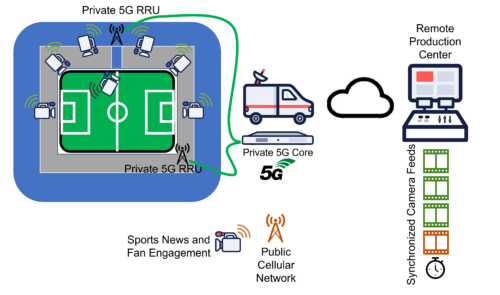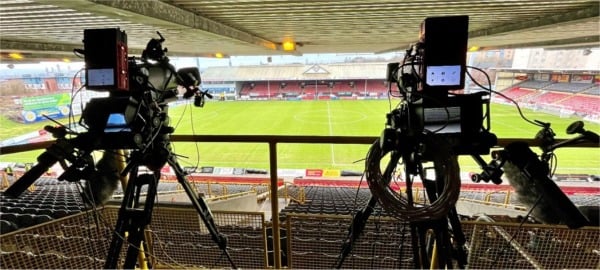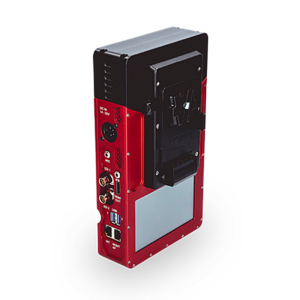Today’s sports viewers have come to expect being immersed in the heart-pounding action of tier 1 sports events, feeling the rush of excitement as if they were right in the stadium. However, while top-tier sports events have dazzled audiences with their high production values, lower tier sports often struggle to bridge the gap and provide an equally captivating experience for fans. Now, a game-changing technology is set to transform the landscape of sports production forever: private 5G cellular networks.
Traditionally, limited budgets have posed significant challenges for TV production companies covering smaller sports events. However, the emergence of private 5G networks has the potential to shift the commercial balance, unlocking new possibilities and delivering a richer, more immersive experience for fans.
These private 5G networks offer unparalleled connectivity tailored specifically to the needs of video production. Boasting uncontended, high data-rate transmission and minimal latency, they provide a bidirectional, IP-native platform that seamlessly integrates into remote production workflows. The deployment of private 5G cells within a sports stadium, and even in additional areas like the players’ tunnels, ensures continuous coverage and enables smooth handovers between cells.
The beauty of these networks lies in their simplicity and cost-effectiveness. A single fiber connection and local power are all that is needed for each 5G antenna site, eliminating the need for extensive cabling and significantly reducing onsite costs. Cameras equipped with 5G wireless transmitters can be positioned in the usual line camera gantry positions, eliminating the need for additional cabling (except for power). For added viewer engagement, free-roaming wireless cameras can capture thrilling Steadicam footage from the sidelines. 
De-cabling an OB Production May Significantly Reduce Production Costs
The core of the 5G network can be hosted in a compact connectivity truck that can be rapidly deployed to the stadium. It can seamlessly interface with stadium fiber backhaul cabinets or leverage alternative means such as the ever-growing Low Earth Orbit (LEO) satellite constellations to backhaul content. This remote production approach centralizes production teams, enabling them to work on multiple events throughout the day and increasing their overall efficiency. The benefits are far-reaching, including reduced travel costs and improved work-life balance for production staff.
The all-IP network from camera edge to production gallery ensures precise time synchronization of multi-camera content. In addition, remote camera control paint functionality, IFB audio, and return channel video to each camera operator take the production quality to new heights. Furthermore, handheld 5G tablet devices integrated into the private network can keep on-screen talent in constant communication with the production team, enhancing pitch-side presentation elements.
 Private 5G Stadium Architecture
Private 5G Stadium Architecture
But the excitement doesn’t end within the stadium walls. By utilizing the same cellular camera transmitters on the public cellular network, camera operators can capture captivating content outside the stadium, showcasing team arrivals, sports news presentations, and fan interviews seamlessly. This innovative approach expands the production possibilities without adding complexity.
5G Provides In-Band Connectivity to the Camera Edge
Vislink has been leading the charge in developing private 5G networks for high-profile sporting events. The company has been a prominent broadcast industry player in designing and deploying private 5G networks for high-profile sporting events, including the MotoGP racing circuit and the 2022 Commonwealth Games. Vislink’s 5G Link product recently received the coveted 2023 NAB Product of the Year award in the remote production category for its ability to streamline and simplify workflows. Among its expanding range of 5G solutions, Vislink’s MVP UltraLink Air 5G camera transmitters and Playout decoders are key components for delivering a complete private 5G remote production solution.
With their low latency, high-quality video transmission and robust bidirectional IP connectivity, Vislink’s 5G solutions simplify video networks, reduce expenses, and create streamlined and flexible broadcast processes, enabling operators to produce content be remotely from any connected location.
The rise of private 5G camera systems, such as those offered by Vislink, is revolutionizing the way sporting events are produced. By delivering immersive viewing experiences for audiences, without the barrier of high-budget production costs, the remote production of tier 2 sports events is entering a new era. The power of 5G is poised to captivate sports fans like never before, enabling them to witness every thrilling moment from anywhere in the world.
Download a PDF version of this document at this link.






